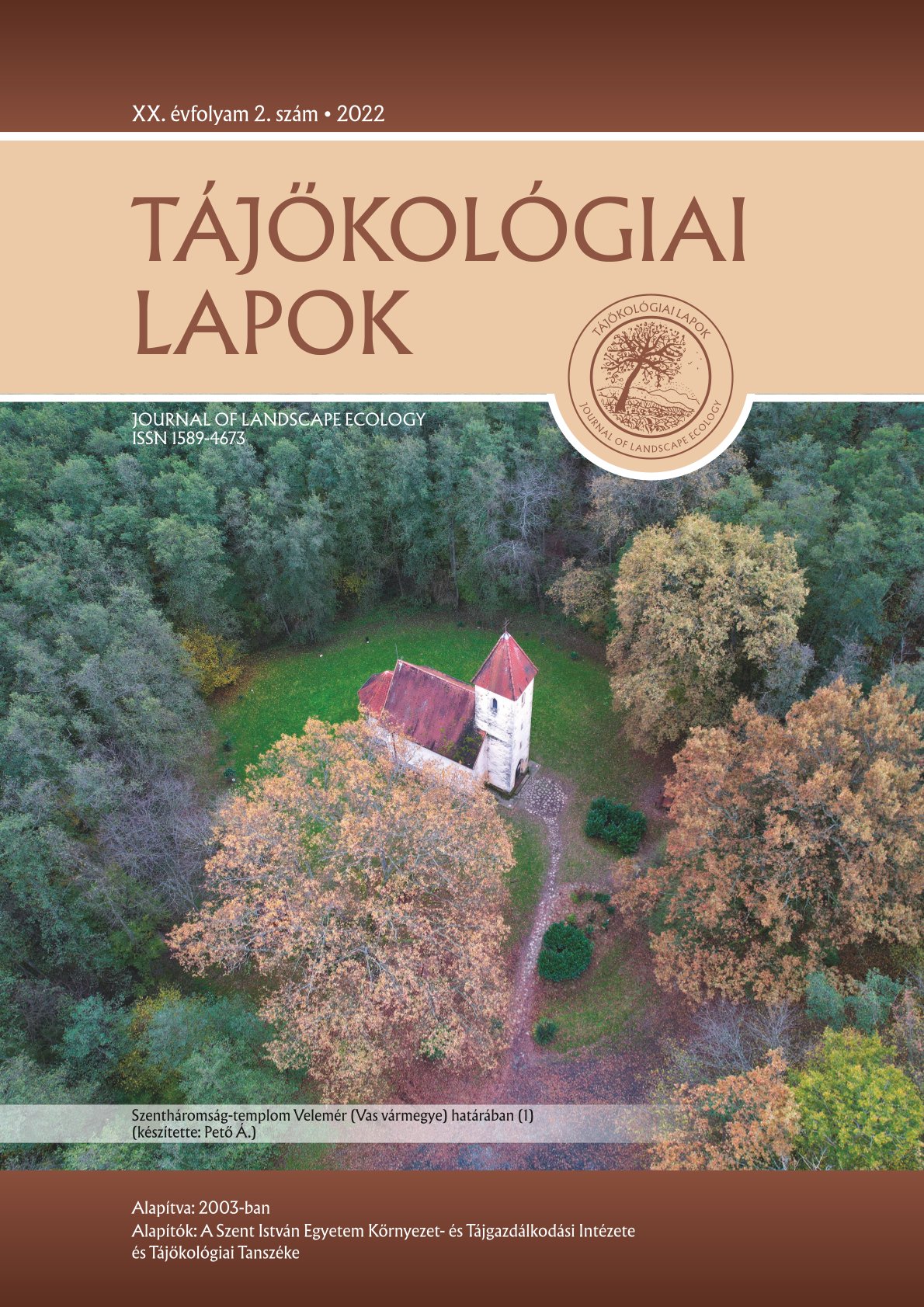The examination of the growth of european beech (Fagus sylvatica L.) stand on the southern slope of Pápavár (Bakony mountains) based on tree-ring measurements – preliminary study
DOI:
https://doi.org/10.56617/tl.3453Keywords:
tree-ring, dendroecology, European beech, Bakony MountainsAbstract
A homogenous European beech forest (Fagus sylvatica) near the settlement of Bakonybél (Bakony Mountains) positioned on a hillside was studied. Soil profiles were opened to describe environmental properties of the forest and 5–5 tree-ring samples (with increment borer) were collected from the lower, the middle and the upper parts of the slope. Soil properties were described based on the soil profiles and the laboratory data of the soil samples, while the growth of the trees was examined by digital measurement (QGIS software) and statistical process [MS Excel, TRiCYCLE, Tellervo and PAST software, hierarchical cluster analysis (UPGMA), ordination analysis (PCA), heatmap method] of tree-ring data.
The soils of the lower and middle parts are luvisols – as typical soils in the surrounding geographical microregion – while the soil of the upper part is eroded, but morphologically-genetically connected to the luvisols of the lower parts of the slope. Based on the tree-rings there is a major difference in the age of trees at the upper part and the lower locations, which might be caused by the one-time forestry practice. We found also major differences in the average height and trunk perimeter of the trees from the different elevations: the trees of the upper part are notably lower, but thicker than the trees of lower positions. Previously mentioned is caused by the exposure and the soil conditions while the later mentioned is connected to the age of the trees. In the growth sequences we found several years when the trees or the whole stand were influenced by external factors. For this reason, we are planning the extension of our research towards the processing of climatic data, extreme weather conditions and events, and forest management.
References
Bartha D., Berki I., Lengyel A., Rasztovits E., Tiborcz V., Zagyvai G. 2018: Erdőtársulások és fafajaik átrendeződési lehetőségei a változó klímában. Erdészettudományi Közlemények 8(1): 163–195. DOI: https://doi.org/10.17164/EK.2018.011
Brewer, P.W. 2014: Tellervo – A guide for users and developers. Laboratory of Tree-Ring Research, Tucson. p. 201.
Brewer, P.W., Murphy, D., Jansma, E. 2011: Tricycle: A Universal Conversion Tool For Digital Tree-Ring Data Tree-Ring Research 67(2): 135–144. DOI: https://doi.org/10.3959/2010-12.1
Campbell, W.A. 1939: Damage from Increment Borings. Division of Forest Pathology, Bureau of Plant Industry, U.S. Department of Agriculture. p. 7.
Csapody I., Csapody V., Rott F. 1966: Erdei fák és cserjék. Országos Erdészeti Főigazgatóság, Budapest. pp. 236–238.
Dövényi Z. (szerk.) 2010: Magyarország kistájainak katasztere. Második, átdolgozott és bővített kiadás. MTA FKI, Budapest. p. 876.
Gál J., Veperdi G. 2005: Dendrometria. Oktatási segédanyag. Nyugat-magyarországi Egyetem, Erdővagyon-gazdálkodási Intézet, Erdőrendezéstani Tanszék, Sopron. p. 109.
Grissino-Mayer, H.D. 2003: A manual and tutorial for the proper use of an increment borer. Tree-Ring Research 59(2): 63–79.
Grynaeus A., Horváth E., Szabados I. 1994: Az évgyűrű mint természetes információhordozó. Erdészeti Lapok 129(7-8): 203–205.
Gyalog L. (szerk.) 2005: Magyarország Földtani Térképe: L-33-36 szelvény (Veszprém) (szerk.: Gyalog KL. 1999), fedett földtani térkép In: Magyarázó Magyarország fedett földtani térképéhez. Magyar Állami Földtani Intézet, Budapest. p. 189.
Hammer, Ø. 1999–2015: PAST – PAleontological STatictics Version 3.06 Reference Manual. Natural History Museum, University of Oslo, Oslo. p. 225.
Hammer, Ø., Harper D.A.T., Ryan, P.D. 2001: PAST – Paleontological Statistics Software Package for Education and Data Analysis. Palaeontologia Electronica 4(1): 1–9.
Keiner R. 1912: A házilagos kitermelés és házi faipar a zirci járásban. Erdészeti Lapok 51(1): 712–715.
Kovács G. 2016: Termőhelyismerettan. Herman Ottó Intézet, Budapest. p. 175.
Maeglin, R.R. 1979: Increment cores – How to collect, handle, and use them. US. Department of Agriculture, Forest Service, Forest Products Laboratory, General Technical Report FPL 25. p. 18.
Majer A. 1976: Félévszázados kísérletek a farkasgyepűi bükkösben. MTA VEAB monográfia 1. pp. 24–28.
Majer A. 1980: A Bakony tiszafása. Akadémiai Kiadó, Budapest. p. 376.
Marosi S., Somogyi S. 1990: Magyarország kistájainak katasztere I–II. MTA FKI, Budapest. p. 1024.
Molnár S., Peszlen I., Paukó A. 2007: Faanatómia. Szaktudás Kiadó Ház, Budapest. pp. 188–189.
MSZ1398:1998. 1988: Talajszelvény kijelölése, feltárása és leírása talajtérkép készítéséhez. Magyar Szabványügyi Testület, Budapest. p. 13.
Munsell Soil Colour Charts 1990: Soil Survey Manual, U. S. Dept. Agriculture Handbook, p. 18.
Oroszi S. 2006: Bakonyi erdők, bakonyi évszázadok. Válogatás két évszázad írásaiból. Erdészettörténeti Közlemények 68: teljes szám.
Pressler, M.R. 1866: Der forstliche Zuwachsbohrer neuester Construction. Tharandter forstliches Jahrbuch 17: 155–223.
Radó D. 1999: Bel-és külterületi fasorok EU-módszer szerinti értékelése. Lélegzet 1999(7-8): melléklet
Schweingruber, F.H. 1996: Tree Rings and Environment-Dendrochronology. Haupt, Bern. p. 609.
Schweingruber, F.H. 2001: Dendroökologische Holzanatomie: Anatomische Grundlagen der Dendrochronologie. Paul Haupt Verlag, Berne. p. 472.
Stefanovits P., Filep Gy., Füleky Gy. 2010: Talajtan. Mezőgazda Kiadó, Budapest. p. 470.
Szaller V. 2012: Útmutató a fák nyilvántartásához és egyedi értékük kiszámításához. Magyar Faápolók Egyesülete. p. 110.
TIM Módszertan 1995: Talajvédelmi Információs és Monitoring Rendszer 1. kötet: Módszertan. Földművelésügyi Minisztérium, Növényvédelmi és Agrár–környezetgazdálkodási Főosztály, Budapest.
Wallner E. 1941: A Bakony erdőtakarójának átalakulása a XVIII. század végéig. Földrajzi Közlemények 69(1): 1–29.
Wallner E. 1943: A Bakony erdőtakarójának jelen képe. Földrajzi Közlemények 71(4): 260–277.
Downloads
Published
Issue
Section
License
Copyright (c) 2022 Saláta Dénes, Takács Mátyás, Hüll László, Pető Ákos

This work is licensed under a Creative Commons Attribution-NonCommercial-NoDerivatives 4.0 International License.
A folyóirat Open Access (Gold). Cikkeire a Creative Commons 4.0 standard licenc alábbi típusa vonatkozik: CC-BY-NC-ND-4.0. Ennek értelmében a mű szabadon másolható, terjeszthető, bemutatható és előadható, azonban nem használható fel kereskedelmi célokra (NC), továbbá nem módosítható és nem készíthető belőle átdolgozás, származékos mű (ND). A licenc alapján a szerző vagy a jogosult által meghatározott módon fel kell tüntetni a szerző nevét és a szerzői mű címét (BY).












